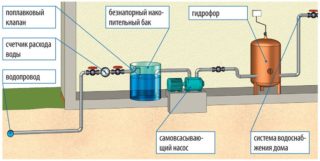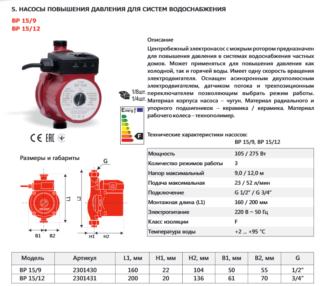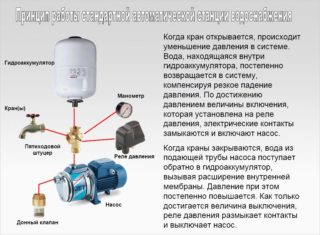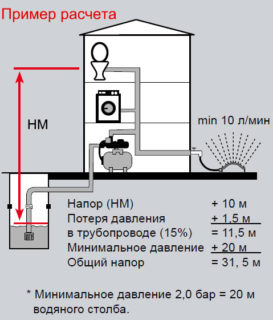The pumping station for increasing the pressure in the water supply system (PNS) serves to maintain the pressure in the main water pipelines and in the schemes of decentralized drinking water supply. The equipment, including several hydraulic machines, transports the water from the intake point to the distribution point.
Purpose and scope
Household stations can be used for the needs of autonomous water supply at home and for irrigation of the site.
Depending on the purpose, the settings are:
- household with low-capacity pumps - used in the private sector for pumping small volumes of water;
- production facilities with powerful hydraulic machines that maintain pressure in the highways of cities and enterprises.
Household pumping stations increase the pressure in the water supply system to provide water to residents of the upper floors. They are automatic and manual, supplied as a set and are immediately ready for use after installation. The installation is straightforward and does not need constant monitoring.
A sensor that monitors the decrease or increase in pressure in the system, depending on the regularity of water use, monitors the activation and deactivation of the pumps. The efficiency of the booster station is increased by multistage units operating in automatic mode.
With manual control, visual control of the operating personnel is required, which monitors the pressure parameters and manually connects the equipment.
The principle of operation and arrangement of stations
- automation, which monitors the change in pressure in the water-folding system, connecting or disconnecting the water intake on time;
- hydraulic machines;
- a water accumulator or tank designed to prevent damage from water hammer.
The emergency water storage tank reduces the number of connection cycles. The structure consists of a cylindrical vessel with a rubber bulb inside. The elastic container is filled with water when the pumps are running.
Station types
Industrial pumping stations are installed at enterprises responsible for water and heat supply to settlements and sewage disposal, especially in cases where it is impossible to use the gravity principle in horizontal sections of the pipeline. They work in automatic mode without the intervention of operating personnel.
There is a wide variety of types, each of which is used for its intended purpose: borehole and circulation, cantilever monoblock and drainage stations, sewer hydraulic machines.
Criterias of choice
The power of the station is associated with its pressure, which determines the height of the rise of water, and productivity - the volume of liquid that the device can pump over a certain period of time. Approximately 15 l / min per flow point.
The maximum lift shows which floor the water can be pumped to. The remoteness of the house from the station matters. Every 10 m of the horizontal section corresponds to a rise of 1 m from the surface. If the distance is 100 m, and the height of the house is 10 m, then the productivity is calculated by the formula: 100: 10 + 10 = 20 m of water column or 2 atm.
The choice of device design depends on the depth of water intake. When increasing the depth, the installation with an ejector is used. This uses the energy of the water raised to the surface. Part of it returns to the ejector system located in the well. At the same time, the volume of the lifted liquid increases.
The larger the volume of the accumulator, the more water will be created. In the event of a power outage, half of it can be used up strategically. The air pressure in the tank is maintained at 1.5 or 2 atm. When this indicator decreases, air is pumped using a pump.
The body is made of cast iron, steel or plastic. The high hygienic properties of stainless steel make it preferable to use.
A large assortment of household PNS is presented by domestic and foreign manufacturers. The Danish company Grundfos and the Russian Caliber have a good reputation.
Features of installation and operation
Before switching on, the pump and the suction hose are completely filled with water. Pump air in the accumulator to P = 1.5 atm.
When testing, the valve in the tank is slightly opened and the device is plugged into an outlet. After 2 or 3 minutes, water should come out of the hose. Repeat the operation if necessary.
The automation setting is checked upon connection. It should pick up when the set points Pmax and Pmin are reached. If the water intake is turned off and the valve is closed, the pump should not operate for more than 10 minutes, as this will lead to overheating and deformation of the elements.
Operational maintenance involves constant supervision of the operation of the device so that, in the event of an emergency, it is possible to quickly take action and minimize possible damage.
Advantages of stations for increasing water pressure

Using an automatic garden pump will not solve the problem of autonomous water supply. The system becomes vulnerable to hydraulic shocks caused by surges in the pressure of the water medium. Sharp changes are associated with a change in flow rate. The advantage of a pumping station is its ability to prevent or neutralize their impact. Repetitive pressure surges reduce the service life of pipelines and valves. They disable the connected plumbing.
The rubber bulb acts as a compensator. It is located in the accumulator. In the drawdown mode, it expands, which dampens pressure fluctuations. The second advantage of the pumping station is smooth regulation.
Elastic membranes are made from various materials:
- durable butyl products - allow pumping hot liquids.
- ethylene-propylene pears - also tolerate high temperatures, but have less strength;
- butadiene-nitrile universal products - used for pumping foodstuffs, liquid fuels, oils and water.
The pumping stations are equipped with a dry-running protection block, since water helps to cool the device and acts as a lubricant. Inlet coarse filters help extend the life of hydraulic machines.











